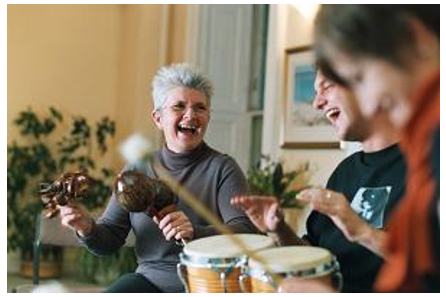As we have seen in the first two parts of this series, sound therapy is an ancient healing practice with spiritual roots. The significance of certain frequencies regarding healing was highlighted in the 1970s, after which sound therapy gained popularity and credibility among health professionals.
Today, hospitals, holistic physicians and spiritual guides alike have embraced a broad spectrum of modalities to bring health and harmony through sound. Sound therapy has proven to be remarkably effective in treating a variety of maladies — presumably due to the ability of resonance to restore balance at the molecular level.
The many benefits of sound therapy
Reduces stress and anxiety

Resonating frequencies can stimulate relaxation at a fundamental level, and seem to touch the very heart and soul. Susy Markoe Schieffelin, sound healer and Reiki practitioner, describes sound therapy as an “energetic deep tissue massage.”
Trends in Cognitive Sciences reported in April 2013 that, for the reduction of anxiety before surgery, listening to music was more effective than prescription drugs. As study conducted during the pandemic suggested that even virtual sound therapy could significantly reduce generalized anxiety
Relaxation and the reduction of stress and anxiety, in turn, have an underlying effect on all areas of health. From improved focus and sleep, to pain reduction and physical healing, this non-invasive — and even pleasant — therapy can deliver surprising results:
Pain reduction
Success
You are now signed up for our newsletter
Success
Check your email to complete sign up
Music therapy has been successfully applied to reduce chronic pain and the pain caused by cancer, medical procedures and burns. By relaxing muscular and mental tensions, vibrational frequencies are a valuable tool for pain management in many cases — including chronic arthritis, athletic injuries and surgery.

Fibromyalgia is a chronic pain syndrome that is often debilitating and difficult to treat. One study on individuals suffering from fibromyalgia showed significant improvement and no adverse effects after 10 brief treatments of low-frequency sound stimulation over the course of five weeks.
Other research studied the effects of pleasant, semi self-selected music on fibromyalgia patients. Listening to familiar, pleasant, relaxing music had an analgesic effect, and yielded a reduction in pain and improved functional mobility.
Immunity booster
Neuroscientist Daniel J. Levitin conducted a meta-analysis of 400 studies, where researchers found music to increase the body’s production of natural killer cells and the antibody immunoglobulin A, effectively boosting immunity.
Heart health
The gentle stimulation of vibrational frequencies can improve blood circulation and lower blood pressure, reducing the risk of heart disease. Sound waves have also been used to help clear blockages in the heart and arteries.

Stroke recovery
A 2008 paper published in the clinical journal Brain revealed that listening to an hour of music daily in the early stages of stroke recovery improved memory, attention and mood. Further research found that structural changes in the areas of the brain responsible for focused attention, verbal memory and language skills were stimulated by music, with vocal music being the most effective.
Revitalizes

In traditional Chinese medicine, there are three main energy centers, or dan (丹); while ayurvedic medicine recognizes seven “chakras.” Sound therapy can help dissolve energy blocks and resolve “stuck” situations to restore a positive attitude and healthy energy flow.
Cancer treatment
While further research is necessary, many experiments have demonstrated that certain vibrational frequencies can destroy cancer cells and retard the growth of tumors, leaving healthy cells unharmed. Research began as early as the 1980s at Jussieu University in Paris, where French musician, acupuncturist and bioenergetician Fabien Maman found that acoustic sounds could cause cancerous cells to become unstable and fall apart.
“When scientific research, spiritual practice and artistic expression work together, heaven and earth are in resonance. This is the vibratory promise that is the gift of our musical universe.”
Fabien Maman
Developmental disorders

Autism spectrum disorder (ASD) is a neurological and developmental disorder that affects how people perceive and interact with others. Ten studies examining the effect of music therapy intervention for children with ASD exhibited positive results, with an improvement in social interaction, communicative skills, and social-emotional reciprocity.
Attention deficit hyperactivity disorder (ADHD) is a neurological and developmental disorder that affects the activity levels, attention and impulsive behavior of millions of children. Studies have found that music stimulates the nucleus accumbens — the part of the brain that coordinates action and motivation — for a significant calming effect on individuals with ADHD. Meanwhile, a structured rhythm can also contribute to focus in subjects with ADHD.
Mental health

Depression is a complex and serious condition affected by numerous factors. While it is believed to be caused by an imbalance of neurochemicals, it could also be described as a lowered energy state, where neurological responses are dulled and vitality fades.
High frequency sound therapy can boost the listener’s vibrational field, along with their emotional state. Depressed individuals exposed to sound therapy have reported increased happiness and greater well-being.
As early as the 1940s, sound intervention was applied to treat psychological disorders in soldiers resulting from wartime atrocities. Now it is believed that music can help people suffering from post traumatic stress disorder (PTSD) by decreasing activity in the amygdala (the brain’s gray matter related to emotional experience) and improving the memory function of the hippocampus.
Sound therapy can also be extremely effective in treating dementia, if introduced early on. By stimulating many different parts of the brain, music and sound therapy help restore normal functioning while providing a welcome sense of relief, balance and connection.
Fringe benefits
Besides the many documented health benefits to sound therapy, there are a number of unsubstantiated claims that certain sounds can improve vision, relieve tinnitus or even promote dental healing.
Fortunately, free virtual therapy is widely available online and negative side effects to sound therapy are virtually unheard of; so there is little to stop you from experimenting and contributing your experience to improved documentation.
One might say it is all in the mind, and that would also be correct — for the mind and body are one. When they resonate in harmony with the universe one can approach perfect health.
READ ALSO
- Tune in to Your Body’s Optimum Frequency (Part II): The Theory and Science Behind Sound Therapy
- Tune in to Your Body’s Optimum Frequency (Part I): The Ancient and Sacred Origins of Sound Therapy
- Understanding Aromatherapy: Why Smells Moderate Mood, and More
Stay tuned for the next and final part of this series, where we will explore a variety of accessible and affordable ways to experience the benefits of sound therapy.













